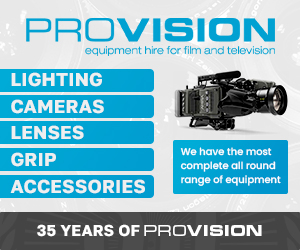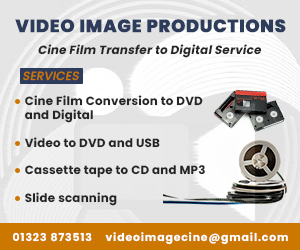Broadcast News
06/04/2016
UHD/4K Production: Video Infrastructure Challenges & Solutions

Many analysts in the broadcast and video service provider industry are predicting that UHD/4K will take off on global scale this year, based on growing consumer demand, says Ian Trow, Senior Director Emerging Technology & Strategy at Harmonic.
In fact, market research firm IHS recently reported that by 2019, more than 50 percent of all households in the United States, Europe and Japan are expected to have smart TVs, with many of these sets being 4K or higher UHD models.
Obviously, before that can happen, a 4K production infrastructure needs to be put in place. Yet, many broadcasters are reluctant to invest much in infrastructure because they've come to the realization that proprietary hardware with bespoke broadcast interfaces will be short-lived in this new virtualized software world.
This article will examine the present state of production infrastructure in the broadcast environment, taking a look at the challenges that operators face when looking to deliver UHD/4K content. Solutions will be discussed, including the benefits of migrating to UHD/4K for ingest and playout.
Current State of Broadcast Production Infrastructure
Right now, the majority of broadcast infrastructure utilized to produce live links is based on 3G SDI. While there's an overall drive in the industry toward IP, it's essentially centered on bespoke broadcast hardware. For scalability to exist, the broadcast industry needs to migrate toward using infrastructure and post-production techniques that allow quick transmission of live events. The methods that are traditionally used for UHD/4K assets in cinema, in terms of color grading and offline editing, are simply not appropriate for live event coverage.
The industry is in a state of paralysis at the moment. Broadcasters are aware of the benefits of standard IT infrastructure, but they also have an eye on quickly addressing the demand for UHD/4K premium assets, in time to provide coverage of the European football championship in France later this year.
As broadcasters look to deploy UHD/4K services, one of the key challenges they face is whether or not to purchase new equipment that is likely to have a short lifespan. Soon enough there will be next-generation Ethernet interfacing on standardized COTS (Commercial Off The Shelf) infrastructure with the capability to handle the functionality and performance of video production as software applications. Light video compression will undoubtedly be used during the production workflow to alleviate the obvious challenges presented by video, namely bandwidth. It’s really a question of balance with using bespoke ingest, playout and switching capabilities in the short term, with the ultimate strategy of transitioning to IP when ready.
What is the Solution?
Broadcasters' UHD/4K video production challenges can partially be resolved by standards and de facto profiles existing. The solution also involves switching over to COTS based infrastructure. There are proof of concepts; however, they don’t yet match the kind of density and performance requirements that are needed for dedicated video switchers in the production environment.
Ingest and playout will play an important role as well. Many broadcasters are looking to upgrade their facility to IP. The end goal is to use as much COTS based infrastructure as possible, creating separation between the underlying processing hardware and the video production specific applications running on it while using IP as the principle interconnect. From a practicality standpoint, most ingest and playout systems available today are not the real deal. They're mainly 3G SDI based, running on bespoke and often proprietary hardware, with an occasional IP interface. Broadcasters need standard COTS-based solutions, where the underlying hardware is standardized, limiting video-specific functionality to software applications. A continual challenge in the production environment is to reconcile the bandwidth needed to sustain video within the capability of the underlying infrastructure. While uncompressed is the ideal scenario from a quality standpoint, the use of compression and file-based workflows have a key role to play to enable the move toward a virtualized, all-IP workflow.
Conclusion
The limited functionality and legacy interfacing of today's ingest and playout systems means that 1080p infrastructure is often being considered as an intermediary while UHD/4K capability emerges on standardized COTS platforms. Ultimately, broadcasters want to migrate to true UHD/4K ingest and playout so that they can deliver superior video quality. Choosing an IP-based system will enable them to bring new levels of efficiency, simplicity and reliability to broadcast playout workflows. At the moment, we are seeing huge demand for these solutions.
Harmonic is expanding the capabilities of its existing products to address the UHD/4K production needs of the broadcast industry. At the 2016 NAB Show, booth SU1210, Harmonic will demonstrate its Spectrum™ X, now supporting UHD/4K, along with a wide range of encoding solutions available as appliances based on standardized hardware or software for vendor implementation.
Clearly, the industry needs true network storage for both 4K and UHD production. The latest capabilities for Spectrum X will go a long way to meet the immediate needs of those embracing quad 3G for UHD playout, with an eye to the future where flexibility to adopt both next-generation IP interfaces (40G/100G) and production appropriate compression will apply.
www.harmonicinc.com
(JP)
In fact, market research firm IHS recently reported that by 2019, more than 50 percent of all households in the United States, Europe and Japan are expected to have smart TVs, with many of these sets being 4K or higher UHD models.
Obviously, before that can happen, a 4K production infrastructure needs to be put in place. Yet, many broadcasters are reluctant to invest much in infrastructure because they've come to the realization that proprietary hardware with bespoke broadcast interfaces will be short-lived in this new virtualized software world.
This article will examine the present state of production infrastructure in the broadcast environment, taking a look at the challenges that operators face when looking to deliver UHD/4K content. Solutions will be discussed, including the benefits of migrating to UHD/4K for ingest and playout.
Current State of Broadcast Production Infrastructure
Right now, the majority of broadcast infrastructure utilized to produce live links is based on 3G SDI. While there's an overall drive in the industry toward IP, it's essentially centered on bespoke broadcast hardware. For scalability to exist, the broadcast industry needs to migrate toward using infrastructure and post-production techniques that allow quick transmission of live events. The methods that are traditionally used for UHD/4K assets in cinema, in terms of color grading and offline editing, are simply not appropriate for live event coverage.
The industry is in a state of paralysis at the moment. Broadcasters are aware of the benefits of standard IT infrastructure, but they also have an eye on quickly addressing the demand for UHD/4K premium assets, in time to provide coverage of the European football championship in France later this year.
As broadcasters look to deploy UHD/4K services, one of the key challenges they face is whether or not to purchase new equipment that is likely to have a short lifespan. Soon enough there will be next-generation Ethernet interfacing on standardized COTS (Commercial Off The Shelf) infrastructure with the capability to handle the functionality and performance of video production as software applications. Light video compression will undoubtedly be used during the production workflow to alleviate the obvious challenges presented by video, namely bandwidth. It’s really a question of balance with using bespoke ingest, playout and switching capabilities in the short term, with the ultimate strategy of transitioning to IP when ready.
What is the Solution?
Broadcasters' UHD/4K video production challenges can partially be resolved by standards and de facto profiles existing. The solution also involves switching over to COTS based infrastructure. There are proof of concepts; however, they don’t yet match the kind of density and performance requirements that are needed for dedicated video switchers in the production environment.
Ingest and playout will play an important role as well. Many broadcasters are looking to upgrade their facility to IP. The end goal is to use as much COTS based infrastructure as possible, creating separation between the underlying processing hardware and the video production specific applications running on it while using IP as the principle interconnect. From a practicality standpoint, most ingest and playout systems available today are not the real deal. They're mainly 3G SDI based, running on bespoke and often proprietary hardware, with an occasional IP interface. Broadcasters need standard COTS-based solutions, where the underlying hardware is standardized, limiting video-specific functionality to software applications. A continual challenge in the production environment is to reconcile the bandwidth needed to sustain video within the capability of the underlying infrastructure. While uncompressed is the ideal scenario from a quality standpoint, the use of compression and file-based workflows have a key role to play to enable the move toward a virtualized, all-IP workflow.
Conclusion
The limited functionality and legacy interfacing of today's ingest and playout systems means that 1080p infrastructure is often being considered as an intermediary while UHD/4K capability emerges on standardized COTS platforms. Ultimately, broadcasters want to migrate to true UHD/4K ingest and playout so that they can deliver superior video quality. Choosing an IP-based system will enable them to bring new levels of efficiency, simplicity and reliability to broadcast playout workflows. At the moment, we are seeing huge demand for these solutions.
Harmonic is expanding the capabilities of its existing products to address the UHD/4K production needs of the broadcast industry. At the 2016 NAB Show, booth SU1210, Harmonic will demonstrate its Spectrum™ X, now supporting UHD/4K, along with a wide range of encoding solutions available as appliances based on standardized hardware or software for vendor implementation.
Clearly, the industry needs true network storage for both 4K and UHD production. The latest capabilities for Spectrum X will go a long way to meet the immediate needs of those embracing quad 3G for UHD playout, with an eye to the future where flexibility to adopt both next-generation IP interfaces (40G/100G) and production appropriate compression will apply.
www.harmonicinc.com
(JP)
Top Related Stories
Click here for the latest broadcast news stories.
09/01/2009
Argosy To Showcase Latest Infrastructure Portfolio At Broadcast Video Expo 2009
Argosy Cable, a leading UK-based international supplier of HD broadcast cables and studio infrastructure products, will showcase its latest range of p
Argosy To Showcase Latest Infrastructure Portfolio At Broadcast Video Expo 2009
Argosy Cable, a leading UK-based international supplier of HD broadcast cables and studio infrastructure products, will showcase its latest range of p
21/05/2024
PlayBox Expands Broadcast Channel Management And Playout Infrastructure
PlayBox Neo has expanded the broadcast channel management and playout infrastructure at the Cairo headquarters of Nilesat, one of the largest telecomm
PlayBox Expands Broadcast Channel Management And Playout Infrastructure
PlayBox Neo has expanded the broadcast channel management and playout infrastructure at the Cairo headquarters of Nilesat, one of the largest telecomm
12/01/2022
Broadcast Solutions Upgrades MAM And Playout Infrastructure For GPB
Following the ambitious aims of Georgian Public Broadcaster (GPB) to transform workflows and renew technology and equipment in their MAM and playout i
Broadcast Solutions Upgrades MAM And Playout Infrastructure For GPB
Following the ambitious aims of Georgian Public Broadcaster (GPB) to transform workflows and renew technology and equipment in their MAM and playout i
28/01/2004
BBC Technology delivers playout infrastructure control to Broadcast Centre
BBC Technology has announced that its Colledia Control system will be used to monitor and control the playout infrastructure at the BBC's new Broadcas
BBC Technology delivers playout infrastructure control to Broadcast Centre
BBC Technology has announced that its Colledia Control system will be used to monitor and control the playout infrastructure at the BBC's new Broadcas
06/07/2011
Panasonic Announce Broadcast & Production Ltd as Authorised Panasonic Broadcast Dealer
Established in 2003, Broadcast & Production Services (BPS) is one of the UK's leading suppliers of broadcast video and audio equipment and effective f
Panasonic Announce Broadcast & Production Ltd as Authorised Panasonic Broadcast Dealer
Established in 2003, Broadcast & Production Services (BPS) is one of the UK's leading suppliers of broadcast video and audio equipment and effective f
31/05/2005
Gee Broadcast and Lightworks to collaborate at the Broadcast Production Show
Gee Broadcast Systems Ltd and Lightworks UK Ltd will exhibit together at the Broadcast Production Show at Earls Court in London from June 1-3 2005. Fe
Gee Broadcast and Lightworks to collaborate at the Broadcast Production Show
Gee Broadcast Systems Ltd and Lightworks UK Ltd will exhibit together at the Broadcast Production Show at Earls Court in London from June 1-3 2005. Fe
09/10/2003
ATG Broadcast to create production village for BBC Broadcast
One of Europe's leading systems integrators, ATG Broadcast, has been selected to design and build a fully digital production village within BBC Broadc
ATG Broadcast to create production village for BBC Broadcast
One of Europe's leading systems integrators, ATG Broadcast, has been selected to design and build a fully digital production village within BBC Broadc
08/01/2014
Broadcast Networks Completes Infrastructure Projects Across Europe
Broadcast Networks have completed a number of diverse broadcast system projects during 2013 for international organisations such as Chellomedia, News
Broadcast Networks Completes Infrastructure Projects Across Europe
Broadcast Networks have completed a number of diverse broadcast system projects during 2013 for international organisations such as Chellomedia, News
11/10/2012
Snell Drives Broadcast Infrastructure At Manhattan Neighborhood Network
The Manhattan Neighborhood Network (MNN) has chosen Snell's Morpheus playout automation, ICE channel-in-a-box, Sirius 128 x 128 router, and Hyperion m
Snell Drives Broadcast Infrastructure At Manhattan Neighborhood Network
The Manhattan Neighborhood Network (MNN) has chosen Snell's Morpheus playout automation, ICE channel-in-a-box, Sirius 128 x 128 router, and Hyperion m
16/07/2012
Argosy To Introduce New Additions To Its Studio And Outside Broadcast Infrastructure Range
Argosy, a leading international supplier of HD broadcast cables and studio infrastructure products, will showcase the latest addition to its product r
Argosy To Introduce New Additions To Its Studio And Outside Broadcast Infrastructure Range
Argosy, a leading international supplier of HD broadcast cables and studio infrastructure products, will showcase the latest addition to its product r
07/11/2018
Invisible Infrastructure: The Future Of Live Production
There is a certain thrill to watching something on screen that's unfolding live, in real-time in a completely different part of the world. This is one
Invisible Infrastructure: The Future Of Live Production
There is a certain thrill to watching something on screen that's unfolding live, in real-time in a completely different part of the world. This is one
13/03/2009
Grass Valley To Deliver New HD-Ready Production Infrastructure For Tunisia
Grass Valley has won a substantial contract to modernise the television infrastructure of la Télévision Tunisienne (TT), the public broadcaser in Tuni
Grass Valley To Deliver New HD-Ready Production Infrastructure For Tunisia
Grass Valley has won a substantial contract to modernise the television infrastructure of la Télévision Tunisienne (TT), the public broadcaser in Tuni
24/04/2007
Sony Professional Services Contracted For GMTV Production Infrastructure Overhaul
Sony Professional Services has been contracted as the solution design consultant, systems architect and project manager for the overhaul of GMTV’s pro
Sony Professional Services Contracted For GMTV Production Infrastructure Overhaul
Sony Professional Services has been contracted as the solution design consultant, systems architect and project manager for the overhaul of GMTV’s pro
31/01/2008
Gee Broadcast Serves Up Video Over IP & Lip Sync Analysis At Broadcast LIVE & VideoForum
On show this year at Broadcast LIVE & VideoForum are the Geevs MR family of flexible Servers for Post Production, Production and Transmission working
Gee Broadcast Serves Up Video Over IP & Lip Sync Analysis At Broadcast LIVE & VideoForum
On show this year at Broadcast LIVE & VideoForum are the Geevs MR family of flexible Servers for Post Production, Production and Transmission working
31/05/2022
CJP Broadcast Completes HD Video Production
CJP Broadcast Service Solutions Ltd has completed a live HD video production of the FA Women's National League Playoff Final. For the first time, the
CJP Broadcast Completes HD Video Production
CJP Broadcast Service Solutions Ltd has completed a live HD video production of the FA Women's National League Playoff Final. For the first time, the















